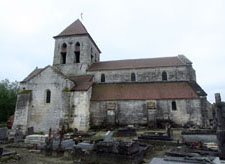Chivy-lès-Étouvelles (Aisne, France) - Saint-Pierre
- Disclaimer
The dating found here is based on the work of John James, and is meant on this site to serve as a starting point. James' dating is derived from a system that uses his interpretation of the development of capitals over time as the basis for chronology, among other factors. His goal is to refine the dating to within years rather than decades. I have not fully embraced James' methodology, and will be developing this page from its current state to one which is admittedly more conservative. The relative expenditure values found in the Timeline are also based on James' work, and I believe these to be reasonably reliable. They are intended only to give a sense of the amount of work involved in each decade.
I have added the idea of the "project" as a way of separating work in buildings. In my mind, a "project" is a discrete section of work in a building that resulted from the one-time acquisition of funding. "Projects" are generally separated by at least a decade where no work was being done. It is my view that it would have been unwise to start a "project" that could not be finished and protected from the elements, and as such a "project" usually involved a wing or multiple wings of a building, from floor to roof. Rural churches, which could only secure small amounts of funding at irregular intervals, often were the result of many small projects, while the great churches, which benefitted from relatively consistent funding, may have involved only a few large projects.
I have added the idea of the "project" as a way of separating work in buildings. In my mind, a "project" is a discrete section of work in a building that resulted from the one-time acquisition of funding. "Projects" are generally separated by at least a decade where no work was being done. It is my view that it would have been unwise to start a "project" that could not be finished and protected from the elements, and as such a "project" usually involved a wing or multiple wings of a building, from floor to roof. Rural churches, which could only secure small amounts of funding at irregular intervals, often were the result of many small projects, while the great churches, which benefitted from relatively consistent funding, may have involved only a few large projects.
- Timeline with Relative Expenditure (if available, in building units)
 |
 |
 |
 |
- Project A - Earlier - Phase 1 -
There was an earlier apse to the east of the apse buttresses, probably round, and a straight bay with high windows and a barrel vault that still exist; the remains of the lower courses would have been buried in the concrete fill in the entry to the apse
- Project B - 1080s - Phase 2 - crossing (a-)
The crossing aisles were built in a number of small campaigns; the western crossing piers with double shafts were erected to theaisle capitals on the north, including the lower six courses of both lateral chapels that are butted into the earlier apse
- Project B - 1080s - Phase 3 - crossing (a)
Western crossing piers side entry arch imposts and the transept walls were raised to match the east
- Project B - 1080s - Phase 4 - crossing (c)
Crossing clerestory, probably without the arch as it was substantially raised later
- Project B - 1080s - Phase 5 - west wall
West wall with north leg of west aisle as a hoarding; the entry arch built with the north aisle window head
- Project B - 1080s - Phase 6 - nave (a)
Nave piers and south aisles walls were added with no buttresses
- Project B - 1090s - Phase 7 - n aisle wall
N aisle wall with pointed doubleau arches;
- Project C - 1120s - Phase 8 - crossing (c+)
Nave clerestory with crossing vault and the west wall and window as the design matches the pre-existing upper west wall; the springing of the arch between apse and nave was raised 4 courses with upper walls of the nave clerestory; crossing vault built with upper walls of crossing because cells let into wall, with 'r' section, supported on head corbels angled to suit ribs; arch into nave raised at the same time;
- Project D - 1160s - Phase 9 - tower II
Second story of the tower;
- Project E - Later - Phase 10 -
After 1240, eastern bay of the apse with tracery and vault; the remnants of the old apse would have been demolished at this time;
